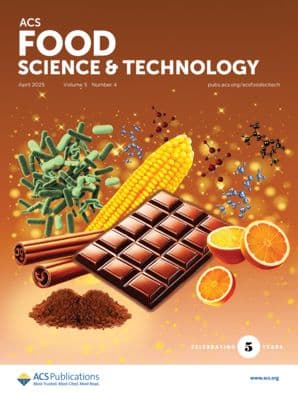Four recent studies in ACS journals highlight the functional applications of berry byproducts and compounds in food preservation, metabolic regulation, and nutraceutical development.

Berries pack a powerful punch with their rich minerals, antioxidants, and other compounds important for health and wellbeing. Enjoyed fresh or in a beverage, dessert, or condiment, berries are as versatile in their application as they are in their flavors, textures, and nutritional benefits. Researchers are increasingly looking to these small but mighty fruits for natural solutions in the food and health sectors. Four recent findings highlight the functional potential of raspberries and blueberries.
Keeping it fresh and tasty
Raspberry powder for preserving ground beef
If you enjoy burgers, it’s safe to assume you want them made with fresh patties. Fresh ground beef, however, has a very short storage life even at refrigerator temperature; you must consume it within 1-2 days. According to a study from Türkiye published in ACS Omega, raspberry powder can help extend the shelf life while preserving the quality of aerobically packaged ground beef, making it a healthy alternative to synthetic preservatives.

Raspberry Powder (Rubus idaeus L.) as a Natural Preservative in Aerobically Packaged Ground Beef: The Phytochemical Profile and Effect on Lipid Oxidation, Color Deterioration, and Microbial Growth during Storage
DOI: 10.1021/acsomega.5c02471
It’s a gut matter
Black raspberry compound for regulating metabolism
Dietary black raspberry polyphenals could be a viable strategy for managing metabolic disorders. Scientists studying the compound’s interaction with gut microbiota observed that it significantly alleviated obesity and associated disorders induced by a high-fat diet in mice. The findings, reported in the Journal of Agricultural and Food Chemistry, contribute to improved understanding of the health benefits associated with the functional components of raspberries.

Black Raspberry Polyphenols Shape Metabolic Dysregulation and Perturbation in Gut Microbiota to Promote Lipid Metabolism and Liver Regeneration
DOI: 10.1021/acs.jafc.5c00702
Extracting the good stuff from waste
Blueberry residues for developing functional ingredients
Due to their sweet flavor and high antioxidant content, blueberries are a popular fruit around the world. But blueberry consumption generates between 30-50% of the fruit’s total weight in residues, which are discarded despite containing valuable nutrients and bioactive compounds. Now scientists in Chile—a leading supplier of the fruit–have published a study in ACS Food Science & Technology aimed at optimizing the extraction of raw material from blueberry residues as the first step in developing functional ingredients.

Optimizing Supercritical CO2 and Accelerated Solvent Extraction for Sustainable Recovery of Functional Compounds from Blueberry Residues (cv. Legacy)
DOI: 10.1021/acsfoodscitech.5c00010
Eyeing a breakthrough in diabetes treatment
Blueberry extract for managing retinal complications
According to recent work in the Journal of Agricultural and Food Chemistry, blueberries may be key to future treatments of diabetic retinopathy, a leading cause of visual impairment and irreversible vision loss globally. In a study conducted in mice, researchers in China found that blueberry anthocyanins helped alleviate retinal damage by modulating gut microbiota and reducing inflammation in the retina. This could provide some hope for the millions of people affected by diabetic retinopathy who are waiting for a therapeutic breakthrough.

Blueberry Anthocyanin Extracts (BAEs) Protect Retinal and Retinal Pigment Epithelium Function from High-Glucose-Induced Apoptosis by Activating GLP-1R/Akt Signaling
DOI: 10.1021/acs.jafc.4c08978
